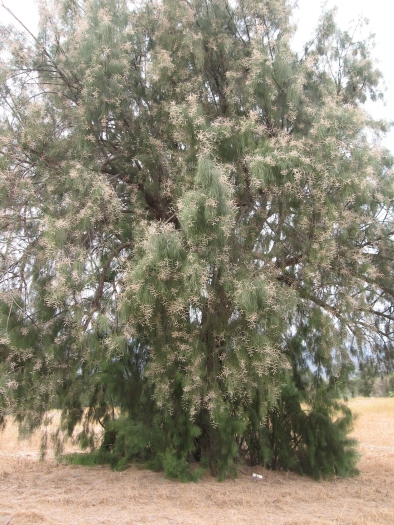Athel Tamarisk
(Tamarix aphylla)
Athel Tamarisk (Tamarix aphylla)
/
/

miheco
CC BY-SA 2.0
Image By:
miheco
Recorded By:
Copyright:
CC BY-SA 2.0
Copyright Notice:
Photo by: miheco | License Type: CC BY-SA 2.0 | License URL: https://creativecommons.org/publicdomain/mark/1.0/ | Uploader: miheco | Publisher: Flickr |
























































Estimated Native Range
Summary
Tamarix aphylla, commonly known as Athel Tamarisk, is an evergreen tree or large shrub native to arid regions including deserts, plains, and saline scrublands in North Africa, the Middle East, the Arabian Peninsula, and Africa. It can grow up to 18 meters (59 ft) in height, with a spread that can be quite wide, providing significant shade. The small, scale-like leaves are alternately arranged along the branches and are capable of exuding salt, which may form a crust on the foliage and drip onto the soil below, potentially affecting the surrounding plant life. This species is capable of reproducing by seed, suckering, or from cuttings, and it blooms with inconspicuous whitish-pink flowers from July to November.
Athel Tamarisk is valued for its ability to provide quick-growing windbreaks and shade in hot, dry climates, making it a useful species in arid agricultural and horticultural settings. Its salt-exuding leaves can help to reduce salinity in the soil over time. In cultivation, it thrives in full sun, requires minimal water once established, and prefers well-drained soils. However, it is important to be aware of its invasive potential; Tamarix aphylla can spread aggressively in suitable climates, outcompeting native vegetation and altering ecosystems. It is considered extremely invasive in regions such as South Africa and Australia, where its presence can lead to increased fire risk due to the accumulation of salt-laden, flammable material. Gardeners should consult local regulations and consider the ecological impact before planting Athel Tamarisk outside its native range.CC BY-SA 4.0
Athel Tamarisk is valued for its ability to provide quick-growing windbreaks and shade in hot, dry climates, making it a useful species in arid agricultural and horticultural settings. Its salt-exuding leaves can help to reduce salinity in the soil over time. In cultivation, it thrives in full sun, requires minimal water once established, and prefers well-drained soils. However, it is important to be aware of its invasive potential; Tamarix aphylla can spread aggressively in suitable climates, outcompeting native vegetation and altering ecosystems. It is considered extremely invasive in regions such as South Africa and Australia, where its presence can lead to increased fire risk due to the accumulation of salt-laden, flammable material. Gardeners should consult local regulations and consider the ecological impact before planting Athel Tamarisk outside its native range.CC BY-SA 4.0
Plant Description
- Plant Type: Tree, Shrub
- Height: 30-50 feet
- Width: 25-50 feet
- Growth Rate: Moderate
- Flower Color: Pink, White
- Flowering Season: Spring, Summer
- Leaf Retention: Evergreen
Growth Requirements
- Sun: Full Sun
- Water: Low
- Drainage: Fast
Common Uses
Bee Garden, Butterfly Garden, Low Maintenance
Natural Habitat
native to arid regions including deserts, plains, and saline scrublands in North Africa, the Middle East, the Arabian Peninsula, and Africa
Other Names
Common Names: Athel-Pine, Atheltree, Athel Tree, Desert Tamarix, Salt-Cedar, Saltcedar, Tamarisk, Tamarix, Woestyntamarisk, Tamariske
Scientific Names: , Tamarix aphylla, Tamarix articulata, Tamarix orientalis, Thuja aphylla, Tamarix pharas, Tamarix faras, Tamarix furas, Tamarix scebelensis, Tetraclinis aphylla,
GBIF Accepted Name: Tamarix aphylla (L.) Karst.